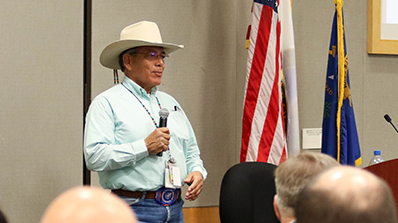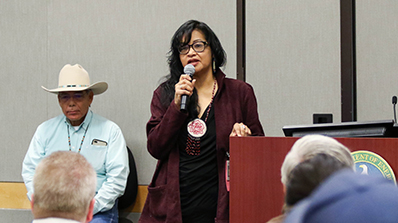
The National Nuclear Security Administration Nevada Field Office (NNSA/NFO) manages an ongoing American Indian Consultation Program (AICP) that interacts with 16 culturally affiliated tribes that have distinct ties to the NNSS. The AICP engages in tribal discussions relating in response to topics of interest including but not limited to cultural resources, archaeological sites, plant and animal resources, traditional cultural properties and sacred sites on the NNSS. As part of this program, NFO hosted an American Indian cultural awareness presentation on Jan. 30, focused primarily on gaining a glimpse into tribal cultures, beliefs and their ongoing interactions at the NNSS.
AICP Coordinator Richard Arnold provided an overview of the program, including the federal drivers, cultural affiliation between the tribes and the NNSS and tribal involvement in Department of Energy (DOE) activities. For the American Indians, protection of the land is sacred. This program ensures that the critical mission work occurring at the NNSS is not infringing on the culturally sensitive areas on the NNSS.
The National Environmental Policy Act (1970), along with the American Indian Religious Freedom Act (1978), the Native American Graves Protection and Repatriation Act (1991), Executive Order 12898 and DOE Order 144.1 serve as the federal drivers for the AICP. A cultural affiliation study conducted in 1986 identified the 16 tribes with cultural and historic ties to the NNSS. These 16 tribes from three ethnic groups (Southern Paiute, Western Shoshone and Owens Valley Paiute and Shoshone) aligned to form the Consolidated Group of Tribes and Organizations (CGTO), following the creation of the AICP in 1991.
NNSS tribal involvement has served as a model for integrating tribal text into the Sitewide Environmental Impact Statement (Appendix C), evaluating and commenting on experimental activities and a series of ethnobotany and ethnofaunal studies that have identified numerous traditional plants and animals that are found on the NNSS. As Arnold stated, “We are working with DOE to become better managers of the resources at the NNSS without impeding the mission.”

To further demonstrate the cultural perspectives, three American Indians – Kenny Anderson, Las Vegas Paiute Tribe; Danelle Gutierrez, Big Pine Paiute Tribe; and Maurice Frank-Churchill, Duckwater Shoshone Tribe – briefly spoke about their connections to the land at the NNSS.
Anderson shared stories about how the Paiutes traveled great distances and gathered essential elements (food and medicines) from the land that is now the NNSS. The Paiutes share a deep connection with this land, which is kept alive through such stories, songs and sharing by tribal members.
Gutierrez shared similar sentiments when speaking about the Owens Valley tribe. “The land is sacred to our people. The land took care of our people,” she stated. She expressed her gratitude for the AICP and the work that is done to protect the land, the animals and the spiritual connection that exists among American Indians. “We honor them through songs and ceremonies,” she added.
Frank-Churchill also spoke about the importance of songs, stories and beliefs. “We are like everyday people, but we follow and continue our traditions, our songs and stories,” Frank-Churchill stated. He echoed the importance of maintaining the spiritual connection to the land because as he said, “The land is disconnected from tribal voices.” Through this AICP program, the American Indians are working to share their storied knowledge with the people currently occupying and performing work at the NNSS.
Arnold wrapped up the presentation with some insight on the balance American Indians have in their lives, tying back to their spiritual connection with the land. He spoke about how most of us are guided by four basic directions (north, south, east and west). American Indians recognize six additional directions:up, down, past, presentandfuture, all of which tie toourselvesand where we fit in the world. A fitting sentiment that aligns with the spiritual connection American Indians share with the land.
